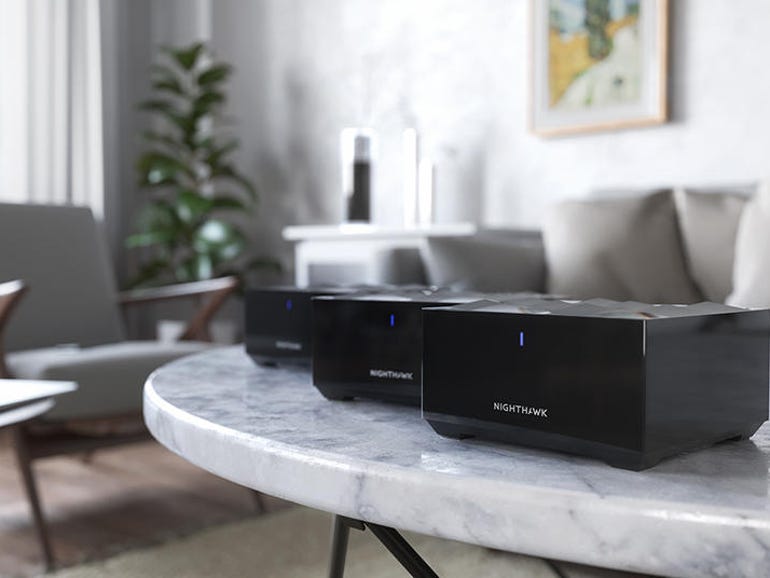
I’ve long used Netgear Nighthawk Wi-Fi routers. They’ve proven to be good solid, small office/home office (SOHO) network gear. But, with the rise of mesh networking, I, and a lot of other people who work at home moved off to mesh-compatible equipment like Netgear‘s own Netgear Orbi Whole Home Tri-Band Mesh Wi-Fi 6 system. But now Netgear is revitalizing its Nighthawk line with the new Nighthawk Tri-band Mesh WiFi 6 System (MK83).
Let’s start with the basics. The new Nighthawk comes with a tri-band Mesh WiFi 6 System 3.6Gbps Router + 2 mesh satellites. Netgear claims it can cover up to 4,500 square feet. I’ll soon be putting it to the test in my not yet finished new office. While it’s only 1,000 square feet, I hope to cover the 2,700 square feet main house with one Wi-Fi system.
In the past, I used Ethernet and Powerline networking to extend my office network, but I’d love it if I could use Wi-Fi instead. Wi-Fi bridges can be difficult to set up; powerline networking has trouble in buildings with older electrical wiring; and separate Wi-Fi access points require their own management and service set identifier (SSID).
Also: How to optimize your network for remote work and learning
To cover all that ground with mesh WiFi 6, mesh uses the IEEE 802.11s standard. This sets the rules so that the main router and its satellites can work in concert with each other and all your equipment. The result is you’ll have far fewer dead spots.
What Wi-Fi 6, also known as 802.11ax, brings to the table is not so much great Wi-Fi speed as it does a much better job of distributing your network’s broadband across multiple devices.
Back when we used to do a lot of business travel you saw this problem all the time in large hotels and event venues. When people were still coming in you had lots of bandwidth. But, as the space is filled up, your bandwidth drops to a slow crawl for an arthritic snail.
Sure, part of the problem is you’re sharing the backbone internet connection with more people, but another major part of it is that the older generation of Wi-Fi routers couldn’t handle connecting well to four or more devices at once. WiFi 6 doubled that to eight simultaneous connections by making better use of Multi-User-Multiple Input, Multiple Output (MU-MIMO) technology than earlier standard devices.
Wi-Fi 6 also uses Orthogonal Frequency Division Multiple Access (ODMFA). With earlier approaches, a Wi-Fi channel is kept open until your data transmission is completed. This left many devices sitting around waiting for their chance. With OFDMA, these channels are divided up into many smaller sub-channels. The net result is instead of lingering around for the next available channel, 30 clients can share a channel instead of taking turns.
Now, you may think, “That’s nice, but what does it have to do with my small office or my home office?” Lots. These days it’s not just our computers and smartphones hooking on to our local network. It’s also our TVs, our smart speakers, and security cameras. According to a 2020 Statista survey, the average American had over ten connected devices in their household. And, that I might add, was before many of us were sent home to work or to go school. The average number of Wi-Fi devices must be much higher by now.
To manage all those connections, the Nighthawk units use a 1.5GHz quad-core ARM processor. This enables the mesh network to keep up with your streaming, gaming, and video conferencing networking needs. Netgear claims that it can deliver a combined Wi-Fi speed of up to 3.6Gbps. In my experience, you’re much more likely to see about a gigabit of speed at most, but most of your high-demand systems, say a 4K TV and two simultaneous Zoom video conferences will have more than enough bandwidth to keep going so long as your main internet can keep up.
It also helps that the new Nighthawk can let you easily set up virtual Wi-Fi networks. So, for example, you can hook up always-connected smart home devices, such as thermostats, locks, lights, garage door openers, and other Internet of Things devices, to their own low bandwidth WiFi connection while computers, smartphones, and bandwidth-hungry TVs, and game consoles are assigned to a different high-speed Wi-Fi network. This segmenting maximizes your network speeds to the gear that needs the speed the most. It also automatically prioritizes video streaming, gaming, and video conferencing applications, such as Zoom and Microsoft Teams with the dynamic Quality of Service (QoS) feature to ensure a seamless experience.
I’ve always been able to optimize my networks, but then I’m also a network administrator. Chances are, you aren’t. This will make getting the most from your SOHO network much easier.
The prices for the Nighthawk Mesh WiFi systems start at $229.99 with dual-band WiFi. The Nighthawk Tri-band Mesh WiFi 6 system is available now for $499.99 for the router and two satellite kit. If you want even more range and speed, check out the Orbi WiFi 6 Mesh systems for coverage of up to 7,500 square feet. The Orbi models range from $549.99 (RBK753) to $999.99 (RBK853) for Netgear’s premium network gear.
Is this cheap? Heck no! But, if you want the most from your network — and these days with many of us working from home we do that’s exactly what we want — based on my experience with earlier Netgear networking equipment, it’s worth the money.
Related Stories:




















